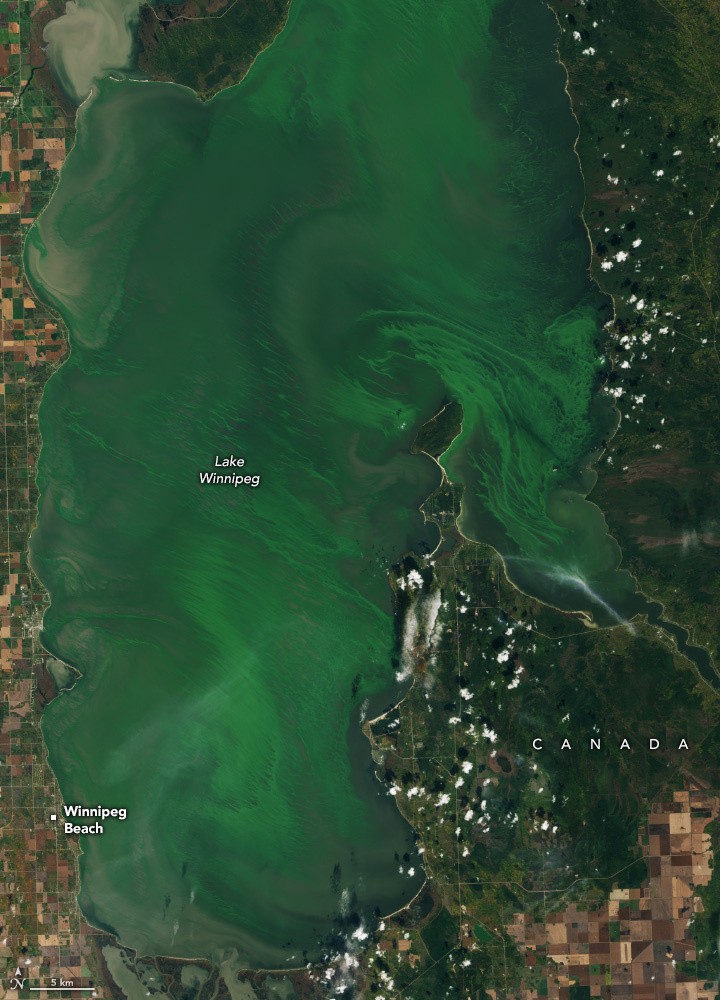NASA's Operational Land Imager-2 (OLI-2) aboard Landsat 9 captured a striking image of Lake Winnipeg on September 25, unveiling vibrant swirls of algae covering the lake's southern basin. Algae blooms have recurrently graced the waters of this sprawling freshwater lake, ranking as the world's 10th largest by surface area since at least the 1990s.
Situated in Manitoba, Canada, Lake Winnipeg boasts a watershed spanning an impressive one million square kilometers (386,000 square miles), draining extensive agricultural regions of Canada. The lake, comprising a substantial deep north basin and a relatively shallower south basin, embodies a diverse aquatic ecosystem.

Algae Blooms in Lake Winnipeg
Around the mentioned date, satellite assessments scrutinized by Environment and Climate Change Canada reported an approximate coverage of 8,400 square kilometers (3,200 square miles) by algae, encompassing roughly a third of the lake's expanse.
According to NASA, blue-green algae, scientifically called cyanobacteria, constitute single-celled organisms reliant on photosynthesis to turn sunlight into food. NASA said the bacteria grow swiftly when nutrients like nitrogen and phosphorus are abundant in still water.
The bloom in Lake Winnipeg may contain blue-green algae and other types of phytoplankton, but only a surface sample can confirm its exact composition. Certain cyanobacteria can generate microcystin, which is a potent toxin linked to skin irritation as well as liver and kidney damage.
Although algae are a natural part of freshwater ecosystems, an overabundance of cyanobacteria and similar species can create difficulties for both residents and tourists who use the lake and its surroundings for recreational activities like fishing and swimming.
During the summer, the beaches along the south basin of Lake Winnipeg attract large crowds, sometimes reaching over 30,000 visitors per day.
Examinations of water samples taken from Winnipeg Beach on the western shore in August detected elevated levels of cyanobacteria. That led to recommendations to refrain from swimming and fishing when noticeable green scum was present.
Concerning Trend on Algae Blooms
NASA highlighted a concerning trend in the ecological well-being of Lake Winnipeg. In the decade between 1990 and 2000, there was a nearly twofold increase in phosphorous concentrations, accompanied by a surge in the frequency and extent of algae blooms.
This spike is primarily attributed to heightened agricultural activities in the lake's watershed and an uptick in flooding events. Phosphorus levels in the south basin of Lake Winnipeg are nearly three times higher than those observed in the north basin.
A comprehensive study conducted in 2019, utilizing data from NASA's Terra satellite and its Moderate Resolution Imaging Spectroradiometer (MODIS), revealed that chlorophyll-a concentrations, used to measure phytoplankton biomass, were more than double in the south basin compared to its northern counterpart.
Related Article : NASA Ingenuity Helicopter Takes 54th Flight; Video From Perseverance Mars Rover Shared on National Aviation Day





![Most Useful Google Chrome Keyboard Shortcuts You Need to Know to Improve Your Browsing Experience [2024]](https://d.techtimes.com/en/full/449047/most-useful-google-chrome-keyboard-shortcuts-you-need-know-improve-your-browsing-experience-2024.jpg?w=184&h=103&f=476d29fd60df70a67f6679f99a2ca6d0)